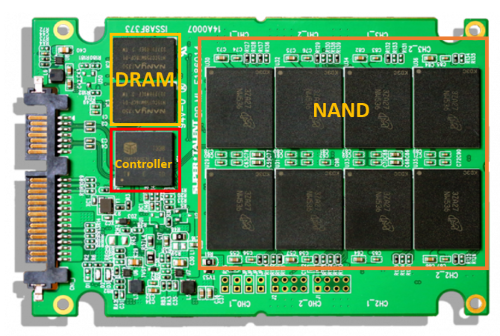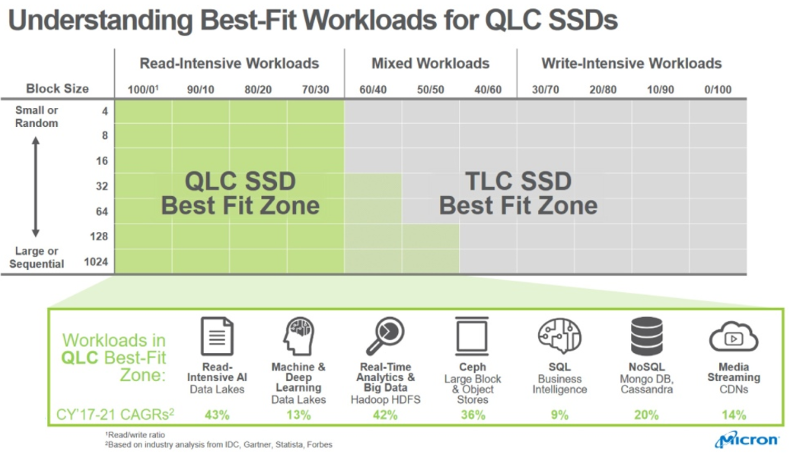Choosing the Right SSD Technology for Expanding Embedded Application Requirements
01/12/2021
Understanding SSD
Detailed analysis of this topic requires understanding the internal structure of SSD:
- NAND flash memory: The part of the SSD that stores data is non-volatile. This means the memory block can save data after the power is turned off.
- DRAM: A small amount of volatile memory (requires power to maintain data) is used as a cache storage for repeated use data.
- Control chip: The main electronic component that connects the NAND flash memory and the computer.

NAND flash memory is a better storage device than traditional hard disk drives. It uses non-volatile storage technology that can save data even after power is turned off. NAND flash memory is composed of multiple storage units in units of bits. These bits are turned on or off via electric charge. The way these switch units are organized when storing data on the SSD also determines the NAND flash. The word “single” in memory naming, such as single-level cell (SLC) flash memory, implies one (a single) bit contained in each memory cell.
SSD circuit board specifications feature industry standardized sizes, therefore a multi-level cell (MLC) can double the capacity within the same physical space. Likewise, a three-level cell (TLC) can triple the capacity. This development paves the way for SSDs with larger capacity. Based on the advantages of performance and size, the current development direction of NAND flash memory is moving towards reducing the storage cost per bit and increasing storage capacity. Therefore, the later four-level cell (QLC) will be designed with storage cells that support 4 bits. Despite this, it is not necessarily “more is better” situation. Different levels of cell NAND flash memory have different characteristics. The following chart is aimed at improving user understanding, and demonstrates NAND flash capabilities through SLC, MLC, TLC, and QLC.

SLC (Single-level Cell)
The Single-level Cell flash features a single bit that can be switched on or off when charged. This type of flash provides several advantages. It is the most accurate when reading and writing data, and lasts the longest during data read and write cycles. In addition, it is the most reliable type of NAND. Conversely, SLC is limited by its cost and is only available in smaller capacities. SLC is ideal for industrial use and workloads that require heavy read/write cycles.
MLC (Multi-level Cell)
MLC flash stores multiple bits of data on one cell. This means a lower cost of manufacturing when compared to SLC flash. MLC flash is more reliable than TLC flash, and supports operation in higher temperature environments, making it an ideal solution for harsh, rugged applications.
3D TLC (Triple-level Cell)
TLC flash features 3 bits per cell and is the cheapest NAND flash technology to manufacture. This type of flash presents one major disadvantage — it is designed for consumer usage and is much less durable that other solutions. Indeed, TLC will survive far fewer read/write cycles when compared to MLC NAND. This means that TLC flash is not suitable for industrial use.
3D QLC (Quad-level Cell)
QLC, or quad-level cell technology refers to a technology that enables each memory cell to save four bits of data. QLC offers a 33% increase in storage space when compared to TLC, but can create write performance and endurance challenges. Reading and writing processes on QLC based SSD provides adequate precision but is much slower than SSDs that store fewer bits per cell. QLC technology is designed to complement to other memory technologies. The following charts demonstrate NAND technology differences when used diverse situations.

Conclusion
Consumers demand high-standard industrial SSDs that support consistent, large capacity data read and write performance in harsh military/factory environments. Transportation applications are a common example of the use of industrial SSDs. Indeed, transportation applications require 24/7 operation, long read/write life cycles, faster read/write speeds, higher reliability, and improved durability and reliability.
Conversely, consumer SSDs are designed for daily office use, are much more affordable, and feature larger storage capacities. Although all SSDs are built to last, their support service should be taken into consideration. Industrial customers need continuously integrated vendor support to sustain business. This is compared to consumer SSDs that only provide RMA swap/exchange processes. We hope you’ve gained a better understanding of the differences between SLC, MLC, TLC, and QLC NAND flash and have a better of idea of why price differences exist. Likewise, we hope this information helps you choose a solution that fits your needs.
SLC Compact Flash
- 96CFS-1G-ET-APU / Apacer 1G CF Card with SLC Flash Wide Temperature
- 96CFS-2G-ET-APU / Apacer 2G CF Card with SLC Flash Wide Temperature
- 96CFS-4G-ET-APU / Apacer 4G CF Card with SLC Flash Wide Temperature
- 96CFS-8G-ET-APU / Apacer 8G CF Card with SLC Flash Wide Temperature
- 96CFS-16G-ET-APU / Apacer 16G CF Card with SLC Flash Wide Temperature
- 96CFS-32G-ET-APU / Apacer 32G CF Card with SLC Flash Wide Temperature
2.5" SATAIII MLC SSD
- 96FD25-S032-TR71 / Transcend 32GB 2.5" SATAIII MLC SSD
- 96FD25-S064-TR71 / Transcend 64GB 2.5" SATAIII MLC SSD
- 96FD25-S128-TR71 / Transcend 128GB 2.5" SATAIII MLC SSD
- 96FD25-S256-TR71 / Transcend 256GB 2.5" SATAIII MLC SSD
- 96FD25-S512-TR71 / Transcend 512GB 2.5" SATAIII MLC SSD
- 96FD25-S1TB-TR71 / Transcend 1TB 2.5" SATAIII MLC SSD
- 96FD25-S032-ITR4 / Transcend Wide Temp 32GB 2.5" SATAIII SSD
- 96FD25-S064-ITR4 / Transcend Wide Temp 64GB 2.5" SATAIII SSD
- 96FD25-S128-ITR4 / Transcend Wide Temp 128GB 2.5" SATAIII SSD
- 96FD25-S256-ITR4 / Transcend Wide Temp 256GB 2.5" SATAIII SSD
- 96FD25-S512-ITR4 / Transcend Wide Temp 512GB 2.5" SATAIII SSD
- 96FD25-S1TB-ITR4 / Transcend Wide Temp 1TB 2.5" SATAIII SSD
M.2 2280 SATAIII MLC SSD
- 96FD80-N032-TR71 / Transcend 32GB M.2 2242 SATAIII MLC SSD
- 96FD80-N064-TR71 / Transcend 64GB M.2 2242 SATAIII MLC SSD
- 96FD80-N128-TR71 / Transcend 128GB M.2 2242 SATAIII MLC SSD
- 96FD80-N256-TR71 / Transcend 256GB M.2 2242 SATAIII MLC SSD
- 96FD80-N512-TR71 / Transcend 512GB M.2 2242 SATAIII MLC SSD
mSATA (MO-300) SATAIII MLC SSD
- 96FD-M032-TR72 / Transcend 32GB mSATA SATAIII MLC SSD
- 96FD-M064-TR72 / Transcend 64GB mSATA SATAIII MLC SSD
- 96FD-M128-TR72 / Transcend 128GB mSATA SATAIII MLC SSD
- 96FD-M256-TR72 / Transcend 256GB mSATA SATAIII MLC SSD
- 96FD-M512-TR72 / Transcend 512GB mSATA SATAIII MLC SSD
- 96FD-M1TB-TR72 / Transcend 1TB mSATA SATAIII MLC SSD
2.5" SATAIII 3DTLC SSD
- 96FD25-S128-TS / SSSTC 128GB 2.5” SATAIII TLC SSD SEMI Wide Temp.
- 96FD25-S256-TS / SSSTC 256GB 2.5” SATAIII TLC SSD SEMI Wide Temp.
- 96FD25-S512-TS / SSSTC 512GB 2.5” SATAIII TLC SSD SEMI Wide Temp.
- 96FD25-S1TB-TS / SSSTC 1TB 2.5” SATAIII TLC SSD SEMI Wide Temp.
